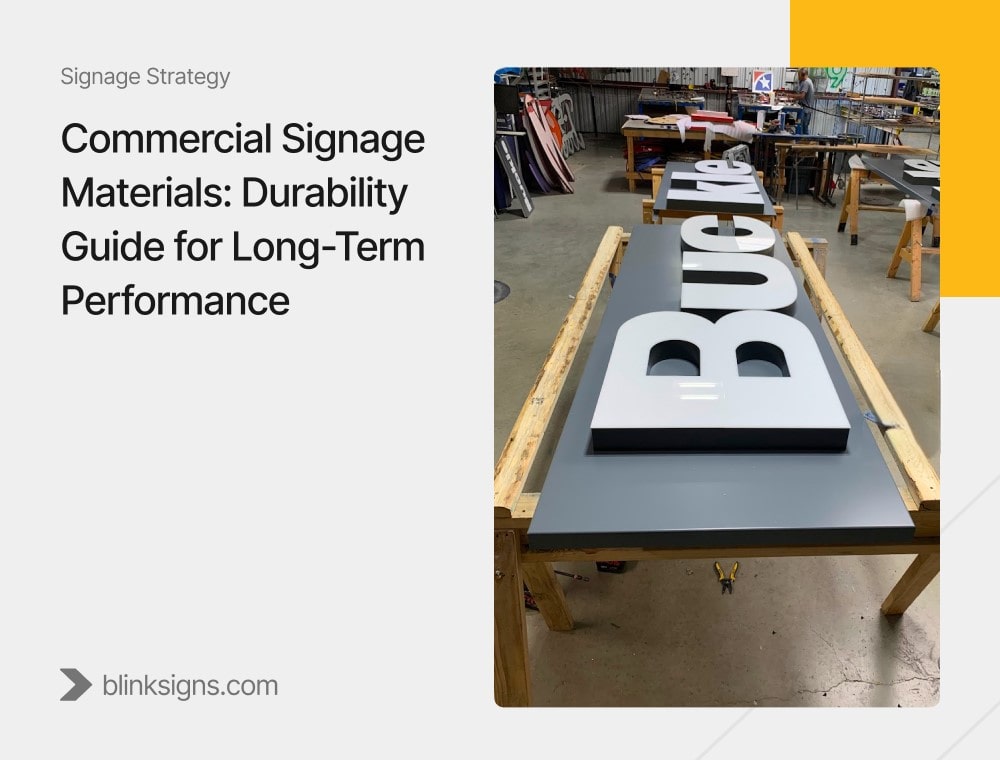
Commercial Signage Materials: Durability Guide for Long-Term Performance
Choosing Materials That Protect Your Brand and Maximize ROI
Your signage is more than just a nameplate, it’s the face of your brand in the physical world. When customers approach your storefront, office, or facility, the quality and condition of your signs communicate volumes about your professionalism, attention to detail, and reliability.
But here’s the challenge: not all signage materials are created equal. What works perfectly for a corporate lobby might fail in a coastal retail environment. That’s why material selection is a strategic decision, impacting brand perception, compliance, maintenance budgets, and your signage’s lifespan.
At BlinkSigns, we help businesses choose signage materials that balance durability, aesthetics, compliance, and cost-efficiency, so your investment continues working for you year after year.
Why Material Selection Determines Long-Term Signage Value
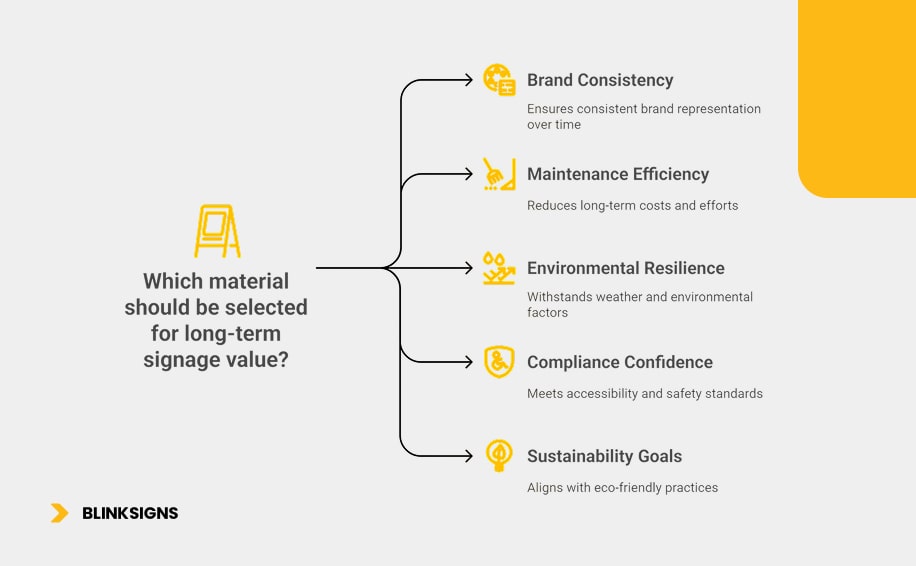
which material should be selected for long term signage value
Choosing the right material is about more than weather resistance, it’s about:
- Brand Consistency: Ensuring colors, finishes, and textures remain true over time.
- Maintenance Efficiency: Reducing the frequency and cost of cleaning, repairs, and replacements.
- Environmental Resilience: Withstanding sun exposure, humidity, wind, or coastal salt without degrading.
- Compliance Confidence: Meeting ADA standards and local codes for accessibility and safety.
- Sustainability Goals: Aligning with eco-friendly materials and low-energy illumination options.
When these elements work together, your signage doesn’t just last, it performs as a long-term marketing asset.
Core Signage Materials and Their Durability Profiles
Below is a comparative table that outlines the most commonly used commercial signage materials, their typical lifespan, durability rating, ideal applications, and maintenance needs.
| Material | Typical Lifespan | Durability Rating | Best Applications | Maintenance Needs |
| Acrylic | 5–10 years | High (Indoor) / Medium (Outdoor) | Lobby signs, illuminated channel letters, wayfinding signage | Occasional cleaning to prevent scratching; protect from prolonged UV exposure |
| Aluminum | 7–15 years | High | Outdoor building signs, pylon sign faces, and dimensional letters | Low maintenance; periodic cleaning; corrosion-resistant in most climates |
| PVC (Expanded Foam) | 3–7 years | Medium | Temporary indoor signs, trade show displays | Avoid prolonged outdoor exposure; wipe clean regularly |
| Stainless Steel | 10–20 years | Very High | Corporate branding, luxury retail signage, monument signs | Minimal; polish to maintain luster |
| High-Density Urethane (HDU) | 8–12 years | High | Dimensional signs, monument sign faces | Occasional repainting/sealing; resists rot and insects |
| Polycarbonate | 7–12 years | High | Backlit signs, illuminated awnings | Clean to prevent clouding; UV protective coating recommended |
| Vinyl (Applied Graphics) | 3–5 years | Medium | Window graphics, vehicle wraps, promotional displays | Replace as graphics fade; avoid harsh cleaning agents |
| LED Illumination Components | 50,000+ hours | Very High | Channel letters, cabinet signs, pylon displays | Minimal; occasional electrical checks |
Matching Materials to Environmental Challenges
Every location presents its own environmental stressors—and using the wrong material can drastically reduce your sign’s lifespan.
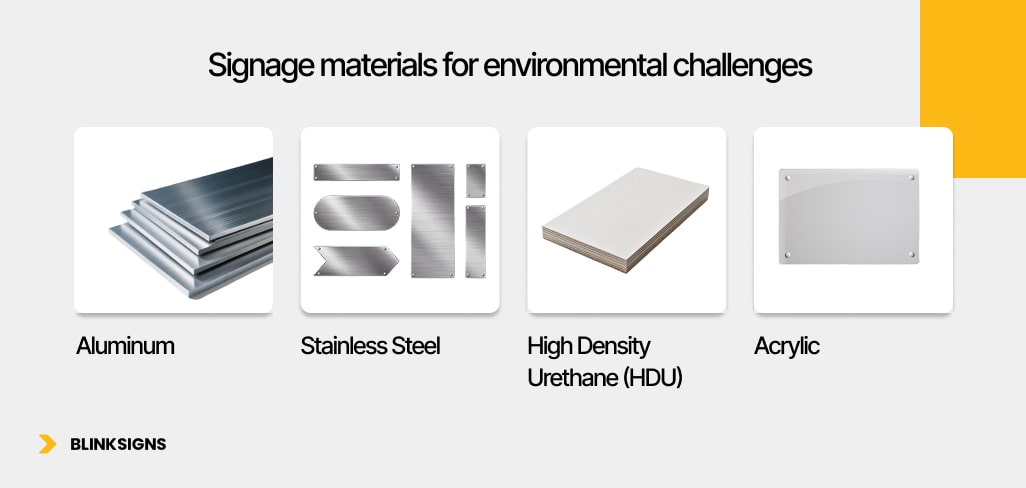
Signage materials for environmental challenges
Coastal Areas:
- Best: Marine-grade aluminum, stainless steel, HDU
- Avoid: Untreated steel, low-grade plastics
- Reason: Salt air and humidity accelerate corrosion and material breakdown.
High Sun/UV Exposure:
- Best: Polycarbonate with UV coating, aluminum with powder coating, HDU with UV-resistant paint
- Avoid: Standard acrylic without UV protection
- Reason: Prolonged sun exposure causes fading, warping, and brittleness.
Cold/Freeze-Thaw Climates:
- Best: HDU, aluminum, stainless steel
- Avoid: Brittle plastics that can crack in freezing conditions
- Reason: Freeze-thaw cycles can expand cracks and compromise the structure.
Urban Environments:
- Best: Aluminum, stainless steel, acrylic
- Reason: Resistant to pollution, grime, and vandalism; easy to clean and maintain.
Industry-Specific Signage Material Recommendations
Material selection is not one-size-fits-all—your industry’s customer flow, branding, and operating conditions play a big role.
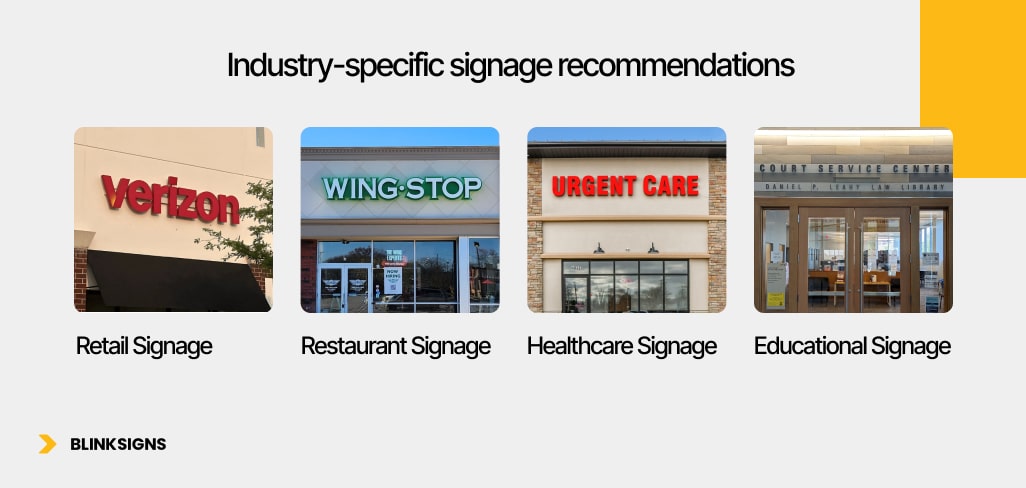
Industry-Specific Signage
Retail & Shopping Centers:
- Durable, high-visibility materials like aluminum, polycarbonate, and acrylic for illuminated channel letters and pylon signage.
- Focus on materials that retain color vibrancy under constant exposure to sunlight.
Hospitality & Restaurants:
- Stainless steel, HDU, and aluminum for brand-forward monument signs and exterior branding.
- High aesthetic finishes for luxury appeal; corrosion resistance for outdoor dining environments.
Healthcare & Corporate Offices:
- Acrylic, stainless steel, ADA-compliant tactile materials for professional, long-lasting interior wayfinding and exterior identification.
Educational Institutions:
- Aluminum, HDU, vandal-resistant finishes for high-traffic and outdoor exposure environments.
Maximizing ROI Through Material Longevity
Choosing a durable material isn’t just about avoiding replacements—it’s about maximizing Return on Investment (ROI) over the full lifecycle of your signage.
How Material Impacts ROI:
- Lower Replacement Frequency → Extended lifespan means fewer production and installation costs over time.
- Reduced Maintenance Labor → Weather-resistant materials require less cleaning and fewer repairs.
- Sustained Brand Image → A sign that looks pristine for years maintains customer trust and brand consistency.
- Energy Efficiency → Modern LED-illuminated signs use less power, reducing operational costs.
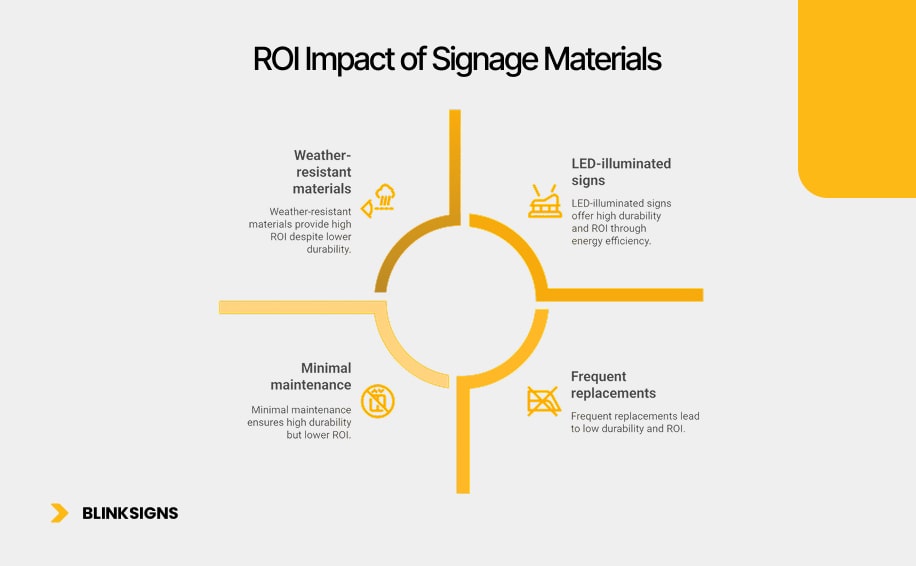
ROI Impact of Signage Materials
Example ROI Scenario:
A marine-grade aluminum monument sign in a coastal environment may last 15 years with minimal upkeep, while a low-grade steel equivalent might rust and require replacement within 5 years—tripling costs over the same period.
Sustainability and Eco-Friendly Material Options
Today’s buyers—and local regulations—are increasingly prioritizing sustainability in signage. Choosing materials with a lower environmental footprint not only supports brand responsibility but can also help with LEED certification points and green building compliance.
Sustainable Material Choices for Long-Term Performance:
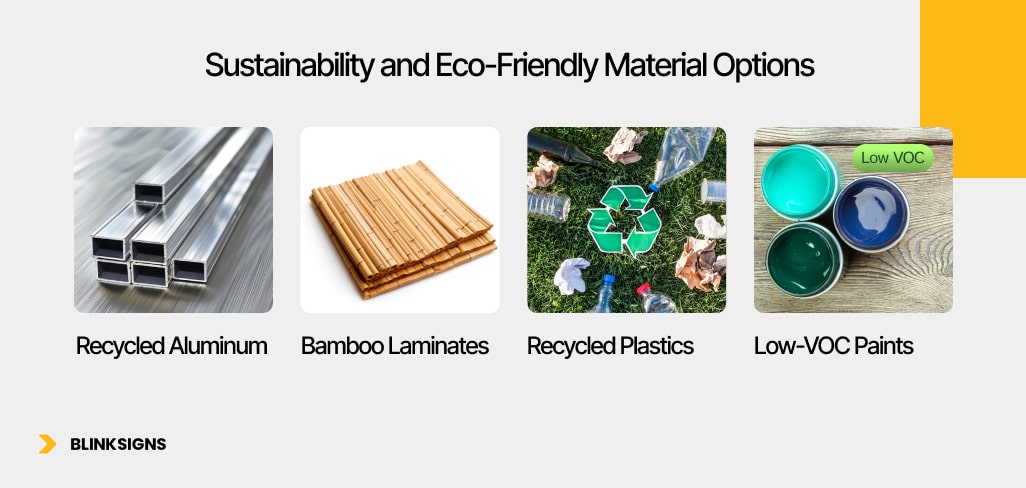
Sustainability and Eco-Friendly Material Options
- Recycled Aluminum → Same durability as virgin aluminum but lower energy footprint.
- Bamboo Laminates → For indoor accent signage; renewable and biodegradable.
- HDU from Recycled Plastics → Long-lasting and eco-conscious.
- Low-VOC Paints & Finishes → Reduce harmful emissions while protecting the sign.
Compliance-Driven Material Selection
Signage durability also includes meeting ADA and local code requirements—because even the most robust sign is a liability if it’s non-compliant.
Key ADA-Compliant Material Features:
- Tactile & Braille Integration → Must maintain legibility and contrast throughout lifespan.
- Non-Glare Finishes → Essential for readability under all lighting conditions.
- High-Contrast Colors → Maintains visibility for visually impaired users.
BlinkSigns ensures every recommended material supports accessibility, safety, and longevity in one integrated solution.
Maintenance Strategies to Extend Lifespan
The right care plan can add years to your signage’s service life.
Material-Specific Maintenance Tips:
- Acrylic: Use a soft cloth and non-abrasive cleaners; avoid ammonia-based solutions.
- Aluminum: Wash with mild soap and water to remove grime; inspect powder coating annually.
- HDU: Reseal and repaint every 5–7 years for outdoor applications.
- Stainless Steel: Wipe regularly to prevent fingerprints and surface spots; polish annually.
- Polycarbonate: Clean with mild detergent; apply UV protectant as needed.
BlinkSigns’ Consultative Approach to Material Selection
Our process is designed to remove uncertainty from your signage investment:
- Environmental Assessment → Analyzing climate, location, and exposure risks.
- Brand Alignment Review → Ensuring finishes and textures reflect your brand personality.
- Compliance Verification → ADA, zoning, and building code checks.
- ROI Projection → Calculating the cost-effectiveness of each material over time.
- Installation & Maintenance Planning → Long-term care guidelines provided upfront.
This approach means your signage isn’t just durable—it’s strategically durable.
FAQ
Q1: What is the most durable material for outdoor commercial signage?
For most environments, marine-grade aluminum is the best option—offering up to 15+ years of life, corrosion resistance, and minimal maintenance needs. In luxury or high-moisture environments, stainless steel is equally strong and visually refined.
Q2: Which signage material requires the least maintenance?
Powder-coated aluminum and stainless steel both require minimal upkeep—just periodic cleaning to maintain appearance and structural integrity.
Q3: How does climate affect signage material choice?
Coastal areas demand corrosion-resistant materials like marine-grade aluminum or HDU. High-sun regions require UV-protected polycarbonate or powder-coated metals to prevent fading and cracking.
Q4: Are eco-friendly signage materials as durable as traditional options?
Yes—recycled aluminum and HDU from recycled plastics match the performance of traditional materials, provided they are installed and maintained properly.
Q5: Can BlinkSigns match materials across multiple business locations?
Absolutely. We maintain a material and finish library to ensure brand consistency across every sign, in every city—no matter the climate or building style.
Conclusion: Material Choice is Brand Protection
Every sign is an ambassador for your brand. The wrong material can fade, crack, or rust—undermining your image and costing you more in replacements. The right material can perform flawlessly for a decade or more, delivering compounded ROI in brand trust, customer impressions, and reduced maintenance.
With BlinkSigns, you get more than signage—you get a partner who understands that material choice is both a design decision and a business strategy. We ensure your investment looks as strong in its tenth year as it did on installation day. Contact BlinkSigns today for a free consultation.